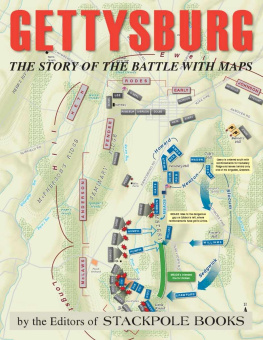The Battle and Battlefield.
WITH
Notes on Banbury & Thereabout.
By
EDWIN A. WALFORD, F.G.S.
SECOND EDITION.
Banbury:
E. A. Walford, 71 & 72, High Street.
London:
Castle, Lamb & Storr, Salisbury Square.
1904.
Preface to Edition, 1904.
For the present edition the available material of the last eighteen years has been consulted, but the plans of battle are similar to two of those of my book of 1886. They were then the first series of diagrammatic representations of the fight published, but in no case has this been acknowledged in the many plans of like kind subsequently published. Some new facts and inferences the author hopes may increase the value of the account.
The letters of Captain Nathaniel Fiennes and Captain Kightley, now added, may serve to make the tale a more living one. They are reproduced, by the kind courtesy of the authorities of the Radcliffe Library, Oxford, and the Birmingham Reference Library.
New pages of Notes on Banbury, and an extended bibliography are also given.
Edwin A. Walford.
Banbury,
March, 1904.
Preface to First Edition.
In the following pages an endeavour has been made to give a concise account of the physical features of the Edge Hill district, as well as to describe the events of the first great battle of the Civil War, with which it is so intimately associated. The intention is to provide a handbook for the guidance of the visitor rather than to attempt any elaborate historical or scientific work. Though Nugents Memorials of John Hampden has supplied the basis of the information, Clarendons History of the Great Rebellion, the various pamphlets of the time, and Beesleys History of Banbury, have also been freely used. In order to avoid burdening the pages with foot notes, a catalogue of works upon the subject is printed as an appendix, and the letters and numbers throughout the text refer thereto. The catalogue, it is hoped, may be of use to the future student. The plans of the battle, based upon Nugents account, must be looked upon as merely diagrammatic, the scale being unavoidably distorted for the purpose of showing the conjectured positions of the troops. In the plans it may be worth note that the troops then known as dragooners are classed with the infantry.
The Notes on Banbury and Thereabouts are in part reproduced from a small pamphlet published in 1879. Much of the detail relating to the older buildings has been derived from Skeltons Antiquities of Oxfordshire and Parkers descriptions in Beesleys History.
To Mr. W. L. Whitehorn my thanks are due for aid in the revision of Edge Hill, and in the compilation of the Notes.
Edwin A. Walford.
Banbury,
July 7th, 1886.
EDGE HILL:
THE BATTLE AND BATTLEFIELD.
I.
T o Edge Hill from Banbury a good road trends gradually up hill nearly the whole way. It rises from the 300 foot level of the Cherwell Vale to 720 at the highest ground of the ridge of the hill. At a distance of eight miles to the North-West is the edge or escarpment of high ground bounded on the East side by the vale of a tributary of the Cherwell, and on the North and West by the plain drained by the tributaries of the Avon. From Warmington, six miles from Banbury, North-Westwards to the point marked on the Ordnance Map as Knowle End, and thence South-Westwards to the Sun Rising, once the site of a hostelry on the Banbury and Stratford-on-Avon coach road, the edge makes a right angle with the apex at Knowle End. The nearest point of the hill range is at Warmington, where a fine fourteenth century Church stands high above the rock of the roadway. There is the first record of the battlea simple headstone to the right of the path to the South porch telling how one Captain Alexander Gourdin had died on October 24th, 1642, the day after the fight. From the church-yard long flights of steps lead to the roadway and village below, where the house tops show through the foliage of the apple orchards in which they are partly hidden. Across the vale, three miles to the North, is the range of the Burton Dassett Hills, an outlier of the Edge Hill range. The Windmill Hill, the most distant, bears the Beacon House; the square tower of Burton Dassett Church may be seen amongst the elms on the lower slopes of Church Hill; Bitham Hill appears in the foreground of the range with the pretty spire and village of Avon Dassett close at hand.
Westward of Warmington Church runs Camp Lane. It winds along the ridge, and commands wide views of the plain lands. A beautiful field path springs from the South side of the lane leading through the village of Ratley to the Round House and Ratley Grange. Facing Southwards, one looks upon an equally pleasant though more circumscribed viewthe vale of Hornton. The Arlescot Woods clothe the Northern slopes, and the Manor House rests amongst the fine trees below. The terraced fields of Adsum Hollow are three miles down vale Southward, and Nadbury Camp, supposedly a Romano-british remain, is but a remnant of similar natural terracing on the South side of the Camp Lane above Arlescot.
At Knowle End, where the road to Kineton plunges steeply down hill, is the first point of the battle ground and the commencement, strictly speaking, of Edge Hill. A short distance down the Kineton Road, a pathway on the right leads under overspreading beech and oak trees for some distance along the crest of the Knoll, whence a good side view of the hill may be got. The gate on the opposite side of the Kineton Road opens to a path through the Radway Woods, and from it, where the foliage is less dense a prospect opens of many wide leagues of fair midland countrya veritable patchwork of field and hedgerow. The furze below covers in part Bullet Hill, the last stand of the Royalists on the battle ground. The road from Kineton as well as the footway through the woods leads to Edge Hill Tower, or Round House. Covering the steep hill sides are beech, elm, chestnut and lime trees of exceptionally fine growth and a wealth of common wild flowers. The Tower or Round House is an inn, which, with a modern-antique ruin, makes as it were a landscape gardening adjunct to Radway Grange lying in the park below. From its upper room is obtained a fine view of the country. It is an octagonal tower, and was erected with artificial ruins in 1750 to mark the spot where the Kings Standard was displayed before the Royalist army descended into the plain to give battle. The village of Radway rests amongst the elms near the foot of the hill, the church spire being one of the prominent objects of the foreground. Kineton lies about four miles directly to the North, beyond which Warwick Castle may be sometimes descried, or the yet more distant spires of Coventry. Some distance from the Burton hills the smoke of the Harbury lime works drifts across the landscape. The farms Battledon and Thistledon, about midway between Radway and Kineton, marked by the coppices which almost hide the homesteads, are noted from the fact of so much of the fight having revolved round them.
The footway to the Sun Rising, 1 miles S.W. of the Round House, follows the hill side, and though still pleasantly wooded, soon gets clear of that heavy growth of foliage which has hitherto shut out so much of the view. The eye ranges over the flat Warwickshire plain in front, to the hills of Gloucestershire and Worcestershire on the West and the North-West. The North-Eastern outliers of the Cotteswolds, the hills of Ebrington and Ilmington, are the nearest in prominence Westwards, beyond which a clear day will allow even the distant slopes of the Malverns to be seen. The Bromsgrove, Clent and Clee hills fringe the North-West horizon, and sometimes the Wrekin is said to appear like a thin cloud far away.







